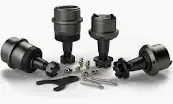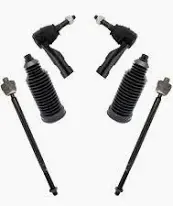

Wholesale Auto Parts in Miami
Wide Selection of Auto Parts for All Vehicle Makes and Models
Suspension
















Suspension FAQ
Understanding your vehicle's suspension system is essential for maintaining a smooth ride and ensuring safety on the road. Here's a comprehensive overview of common suspension components, their functions, signs of wear, and recommended replacement intervals.
1. Shocks and Struts
Function: Shocks and struts absorb road impacts, control vehicle movement, and maintain tire contact with the road, contributing to ride comfort and handling.
Signs of Wear:
-
Excessive bouncing after hitting bumps or potholes.
-
Difficulty controlling the vehicle during turns or lane changes.
-
Uneven tire wear patterns.
-
Squeaking, clunking, or knocking noises over rough terrain.
-
Nose-diving during braking.
Replacement Interval: It's generally recommended to inspect shocks and struts every 25,000 to 30,000 miles and replace them between 50,000 to 100,000 miles, depending on driving conditions and vehicle usage.
2. Ball Joints
Function: Ball joints connect the steering knuckles to the control arms, allowing for smooth steering and suspension movement.
Signs of Wear:
-
Clunking or knocking noises during turns or over bumps.
-
Vibrations in the steering wheel at higher speeds.
-
Uneven or premature tire wear.
-
Steering wandering or reduced responsiveness.
Replacement Interval: Ball joints can last the life of the vehicle or may need replacement earlier, depending on driving conditions. Regular inspections are crucial, especially if you frequently drive on rough roads.
3. Control Arms
Function: Control arms connect the wheel assembly to the vehicle's frame, allowing for controlled wheel movement and contributing to ride stability.
Signs of Wear:
-
Clunking or knocking noises when driving over bumps or turning.
-
Uneven tire wear.
-
Vibrating steering wheel.
-
Poor handling or suspension performance.
Replacement Interval: Control arms can last a long time but should be inspected regularly, especially if you notice any of the symptoms above. Driving on rough roads can accelerate wear.
4. Steering and Suspension Bushings
Function: Bushings act as cushions between parts, controlling movement and reducing road noise, vibration, and harshness.
Signs of Wear:
-
Visual damage such as tears or breaks in the rubber.
-
Changes in tire wear patterns.
-
Increased road noise or vibrations during driving.
Replacement Interval: Bushings should be inspected regularly, especially if you experience any of the signs of wear. Driving conditions and exposure to elements can affect their lifespan.
General Maintenance Tips
-
Regular Inspections: Have your suspension components inspected annually or whenever you notice changes in ride quality or handling.
-
Address Issues Promptly: Ignoring signs of wear can lead to more extensive damage and costly repairs.
-
Consult Professionals: If you're unsure about the condition of your suspension components, seek advice from qualified mechanics.
Maintaining your vehicle's suspension system is key to ensuring safety, comfort, and longevity. Regular inspections and timely replacements of worn components will keep your vehicle performing optimally.








